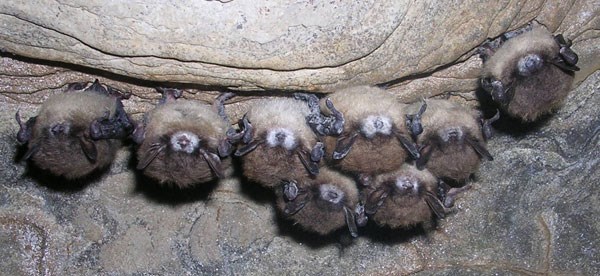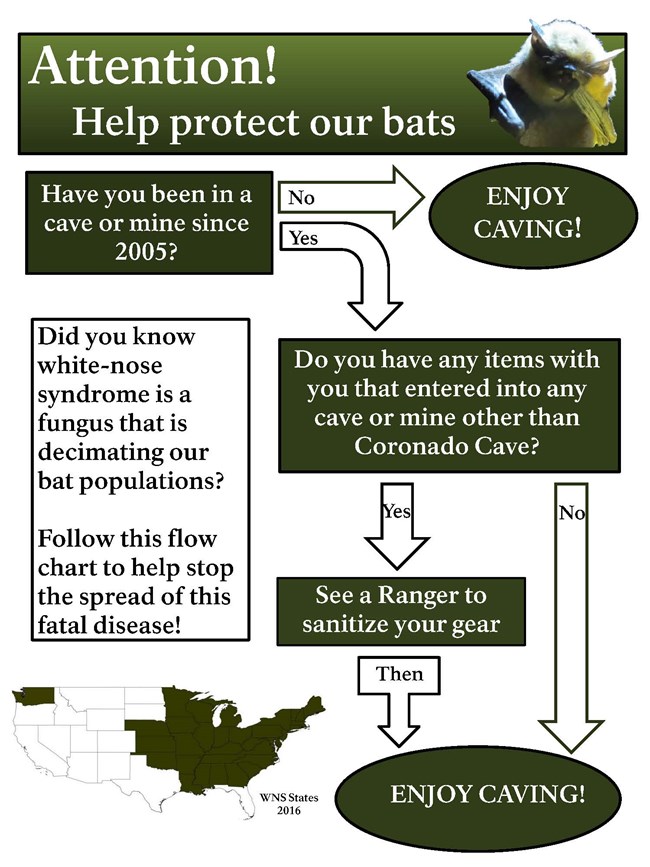
Photo: Nancy Heaslip, New York Department of Environmental Conservation. Cold, humid environments such as caves and mines are the perfect incubators for the fungus. The fungus grows best in temperatures ranging from 54.5°F to 60.4°F, and can tolerate temperatures as high as 67.6°F (12.5-15.8°C, 19.8°C). Unfortunately, this type of environment is also used by many hibernating bat species, putting their future at risk. During hibernation many bats will gather together, and their close proximity to each other makes it easy for the fungus to spread. The fungus is not always visible on bats, but it often appears around their noses, mouths, and wings. Bats need to conserve energy to survive hibernation, but bats with WNS act abnormally, waking up and flying during the day or during freezing temperatures. This activity increases their metabolism, uses up their fat stores, and causes bats to starve to death. Over 90% of bats that contract WNS fungus die. Scientists are looking into treatments and have seen some recent success on a small scale. As of early 2016, the disease has decimated bat populations from northern Georgia to southern Canadian provinces. Many of the affected bat populations migrate north and south across their range; very few bats migrate east and west, especially across the Rocky Mountains. However, humans using contaminated gear or clothing from caves east of the Rockies could potentially spread WNS. In February 2025, an Arizona bat tested positive for Pseudogymnoascus destructans (Pd) in a cave near Fort Huachuca, Arizona, which is on the northern end of the Huachuca Mountains. Coronado National Memorial is on the southern end of the Huachucas and, as of August 2025, has not had any reported cases of WNS. However, it has many mines that bats such as the lesser long-nosed bats use as post-maternal roost sites, so we are continually monitoring. Since the lesser long-nosed bat is a small migratory bat that prefers to roost in large colonies, it is an ideal candidate to be impacted by WNS. The temperatures of many roosting sites in Arizona are warmer than caves and mines in the eastern half of the U.S., so some scientists hope Arizonan caves and mines might be too warm for the fungus to live. The lesser long-nosed bat flies to Mexico for the winter and does not hibernate in Arizona, which lessens the risk to this endangered species. Learn more at whitenosesymdrome.org 
The National Park Service, along with many other organizations, is implementing a national action plan to mitigate WNS where it has occurred. The action plan outlines ways to minimize WNS’s impact as it spreads. Nationally addressing WNS and its spread could provide a template for dealing with future widespread animal disease outbreaks. Current research does not indicate WNS spreading from bat to human. If you have been in any cave or mine other than Coronado Cave since 2006, please stop at the visitor center before your visit to Coronado Cave for decomtamination wipes. Basic decontamination includes using antibacterial/fungal wipes on any cameras, water bottles, flashlights, soles of boots, or backpacks that were potentially exposed to WNS. In some circumstances, it may be necessary to not use any gear or clothing that could have been exposed to WNS. While exploring any cave, please cave softly and leave no trace of your visit. General cave softly principles include not touching the formations, not going to the bathroom in the cave, and leaving dogs and pets at home. Be respectful of other visitors and use quieter voices while in the cave. See our section about Coronado Cave. |
Last updated: August 25, 2025
